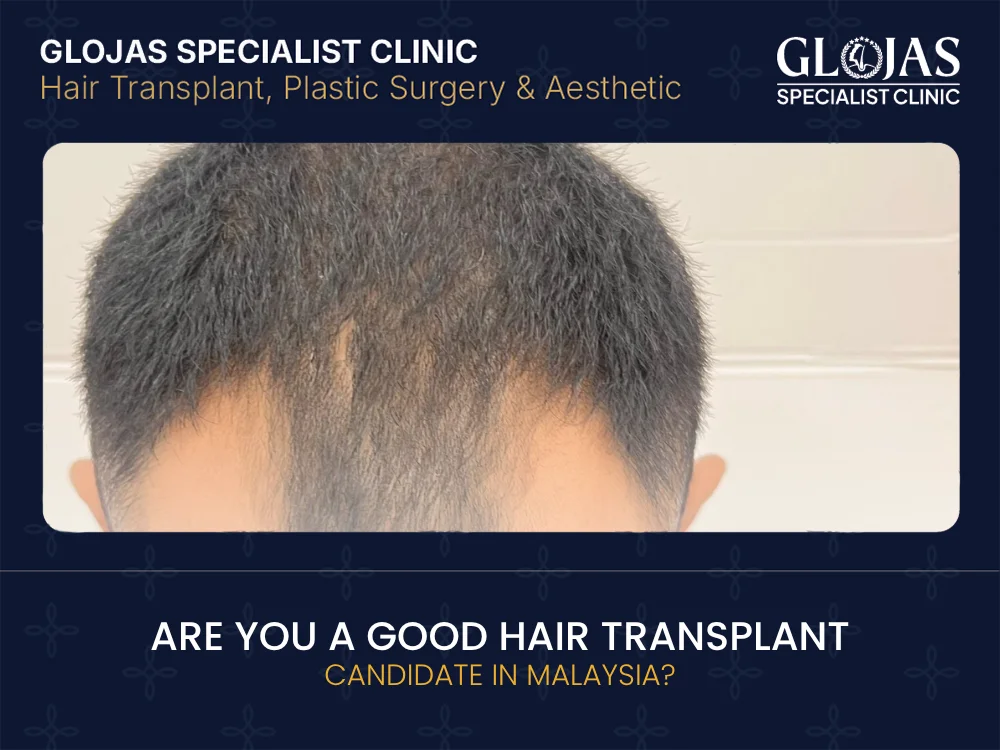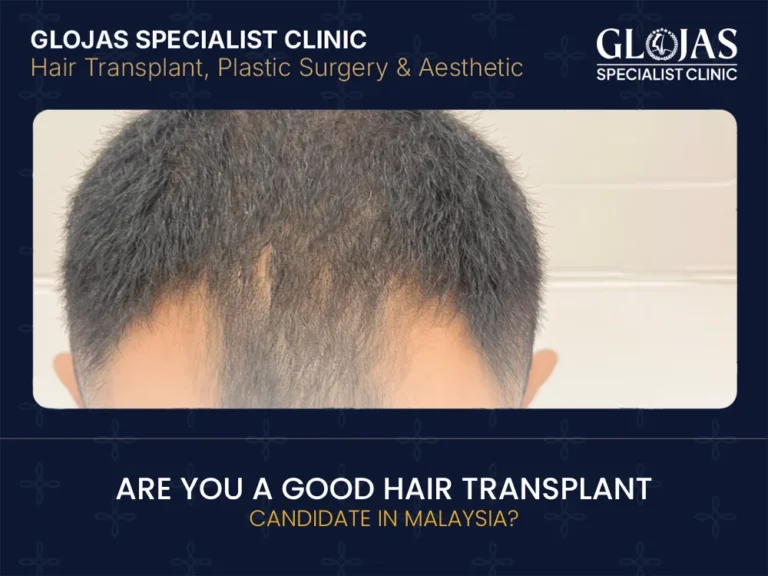If you’re reading this, chances are you’re considering signing up for a hair transplant—or at least exploring whether you’re eligible. But who really qualifies? In this guide, we’ll dig into hair transplant candidate criteria, how specialists evaluate you, local context in Malaysia, and how to choose a clinic you can trust.
What Does “Hair Transplant Candidate” Mean?
A hair transplant candidate refers to a person whose scalp, donor hair, health status, and expectations align well enough that a hair restoration procedure has a good chance of success. Not everyone who’s losing hair makes a good hair transplant candidate candidate. A proper assessment by a certified specialist helps determine whether you’re likely to benefit.
Key Criteria for Being a Good Hair Transplant Candidate
Below are the main factors that specialists consider when deciding whether someone is a suitable hair transplant candidate candidate.
1. Age & Stage of Hair Loss
- Stable hair loss is important: If your hair is still rapidly receding, a transplant now might look unnatural later.
- Many surgeons prefer patients to be 25 years or older (though exceptions exist).
- If you’re in the early stages of pattern baldness (Norwood II–IV), the prognosis is generally better.
2. Donor Hair Quality & Density
- A strong donor zone—typically the back or sides of the scalp—must have adequate follicular units, thickness, and resistance to DHT (dihydrotestosterone).
- If donor hair is too thin or too sparse, you may not get the desired density in recipient areas.
3. Scalp Condition & Elasticity
- Your scalp should be healthy, free from active infections, severe scarring, or dermatologic disease (e.g. uncontrolled psoriasis or eczema).
- Good scalp elasticity helps in harvesting grafts (especially in FUT, though less critical in FUE).
4. Overall Health & Medical History
- Good general health: no uncontrolled diabetes, bleeding disorders, autoimmune disease that attacks hair follicles, or conditions that impair healing.
- Non-smoker or willing to stop smoking before and after procedure to help healing.
5. Expectation Management & Realism
- You must understand what a transplant can and cannot
- It’s not “full regrowth in one day.” Patients must accept that achieving natural density takes time (months) and sometimes multiple sessions.
6. Prior Treatments & Medications
- Prior use of hair-loss medications like finasteride or minoxidil can help stabilize loss, but they don’t guarantee transplant success.
- If you’re on medications (e.g. anticoagulants) or have conditions (e.g. alopecia areata), evaluation is necessary.
7. Psychological Readiness
- It’s a surgical procedure with recovery, some discomfort, and waiting time for results.
- Stress, unrealistic expectations, or impulsive decision-making can impair satisfaction.
Specific Considerations in Malaysia
- Malaysia has become a regional hub for hair transplant and medical aesthetic tourism. Clinics often highlight 25+ years of experience and international accreditation.
- Some Malaysian clinics are led by ABHRS diplomates and ISHRS fellows (e.g. Dr. Inderjit Kaur is listed with those credentials)
- When choosing a clinic, check whether the surgeon (not just technicians) performs non-delegable parts of the surgery, which is a requirement per ABHRS ethical guidelines
- Clinics often promise high graft survival rates and minimal scarring; confirm via real before-and-after photos and patient reviews.
- Because the climate is humid, scalp care protocols (post-op cleansing, drying, avoiding fungal growth) are especially important.

Step-by-Step How Specialists Evaluate You
- Initial consultation & history
You’ll share your hair loss pattern, family history, medical history, medications, and your goals. - Scalp & donor assessment
The surgeon examines hair density, scalp laxity, donor supply, and follicle quality under magnification. - Photographic documentation & mapping
The surgeon draws possible hairline designs, estimates graft count, and simulates possible coverage. - Laboratory tests
Blood tests may check for thyroid, hormones, iron levels, or coagulation markers in some cases. - Treatment plan
Deciding FUE vs FUT, number of grafts per session, timelines, and contingency planning.
If everything aligns, you might be approved as a hair transplant candidate. If not, the specialist might recommend medical (medications, PRP) or non-surgical alternatives first.
Risks & Contraindications: Why Some People Are Not Hair Transplant Candidate
Some conditions or traits make hair transplant ill-advised or risky:
- Diffuse unpatterned hair loss (DUPA): hair thinning across the donor area, leaving poor harvesting potential.
- Active scalp diseases like lupus, lichen planus, fungal infection, or untreated alopecia areata.
- Uncontrolled medical illnesses like uncontrolled diabetes, heart disease, or immune suppression.
- Poor wound healing or scarring tendencies (keloid history).
- Unrealistic expectations or psychological disorders (body dysmorphic disorder).
- Very young age with uncertain pattern: hair may continue receding unpredictably.
If a hair transplant candidate is ruled out, the surgeon may suggest medical therapies first (e.g. minoxidil, finasteride, low-level laser therapy, PRP) and reevaluate later.
Tips to Improve Your Candidacy
- Stabilize hair loss via medication (if suitable).
- Adopt a scalp-friendly lifestyle: quit smoking, manage stress, maintain nutrition.
- Avoid tight hairstyles or harsh treatments that damage follicles.
- Keep the donor area in good health (e.g. gentle scalp massage).
- Wait until your loss pattern has matured (usually a year or more) before final commitment.
Why Choosing a Certified Specialist Matters
When you choose a surgeon certified by ABHRS (American Board of Hair Restoration Surgery) and ISHRS (International Society of Hair Restoration Surgery), you ensure:
- The surgeon adheres to globally accepted standards of care.
- The surgeon personally performs critical surgical steps (not outsourcing non-delegable work).
- Ethical advertising and transparency about graft survival, risks, and outcomes.
GLOJAS Specialist Clinic, for example, is ABHRS and ISHRS–certified and backed by over 25 years of experience in hair restoration. That means you’re engaging a team with deep domain expertise committed to safe, transparent, and high-quality results.
What Happens After Your Transplant: Timeline Overview
Period | What to Expect | Key Milestones |
Days 1–7 | Healing, scabbing, mild swelling | Follow wash/dressing protocol |
Weeks 2–8 | Transplanted hairs “shock-shedding” | Don’t panic — this is normal |
Months 3–6 | New growth begins | 20–50% hair density return |
Months 6–12 | Density increases, maturity | Final texture starts showing |
After 12 mo | Full maturation | Up to 80–90% of expected density |
It often takes 9–12 months (sometimes up to 18 months) to see the full outcome. Multiple sessions may be needed depending on your goals.
How to Select the Right Hair Transplant Clinic in Malaysia
- Check credentials: Ensure the surgeon is a member or diplomate of ABHRS / ISHRS.
- Review valid before-and-after gallery of real, documented cases.
- Ask about graft survival rate, and how they calculate it in their clinic.
- Confirm whether non-delegable steps are done by the surgeon, not technicians.
- Ask about post-op care, follow-up, and guarantee policy.
- Read patient reviews, both local and international, and check independent forums.
- Ensure transparent pricing—no hidden graft fees or add-ons.
- Visit the clinic or request a virtual tour to assess hygiene, staff, equipment, and atmosphere.
Example: How GLOJAS Specialist Clinic Aligns With Best Practices
- GLOJAS is ABHRS and ISHRS certified and has over 25 years of experience in the field (as stated).
- Surgeons at GLOJAS personally oversee and perform critical surgical steps (consistent with international ethical guidelines).
- They provide full diagnostic workups, realistic expectations, and patient care throughout the journey.
- By choosing them, you gain both local convenience (in Malaysia) and international standards of care.
If you’re ready to begin your evaluation, schedule a consultation with GLOJAS Specialist Clinic and talk with their ABHRS / ISHRS–certified team.
10 Frequently Asked Questions (FAQs)
- Am I too old or too young for a hair transplant?
Age isn’t a strict barrier. What matters is stable hair loss and realistic expectations. Very young individuals may still have unpredictable hairline progression; older patients must be healthy enough for surgery. - Can women be hair transplant candidate?
Yes — female pattern hair loss or focal bald patches can sometimes be treated with transplants if donor supply and scalp condition are favorable. - How many grafts will I need?
It depends on the size of the bald area, hair thickness, and desired density. A small hairline restoration might need 1,500–2,500 grafts; larger crowns may require 3,000–4,500 or more. - Is the procedure painful?
You’ll receive local anesthesia. After that, pain is generally minimal. Some soreness or tightness may persist for a few days. - How long is the downtime?
Most patients return to light social activities in a few days, though strenuous exercise is usually postponed for 2–3 weeks. - When will I see results?
New growth usually starts around 3–4 months, with noticeable improvements by 6 months. Full maturation often takes 9–12 months or more. - Can I combine treatments (PRP, finasteride) with a transplant?
Yes, combining medical therapies (PRP, finasteride, low-level laser) can help optimize outcomes and preserve native hair. - What if I have diffuse thinning on the donor zone (DUPA)?
DUPA makes you a poor hair transplant candidate unless the condition stabilizes or alternative donor sources (body hair) are considered with caution. - Are there any risks or complications?
Yes — infection, scarring, graft rejection, unnatural hair direction, poor survival. But choosing a certified, experienced surgeon reduces these risks significantly. - Can I have multiple sessions, and is that okay?
Yes, many patients have staged sessions to build density. But your surgeon should plan to avoid over-harvesting and ensure future donor area integrity.
Final Thoughts
Choosing to undergo a hair transplant is a serious decision. Being evaluated as a good hair transplant candidate means you not only have physical suitability but also realistic expectations, good health, and a trustworthy surgeon by your side.
In Malaysia, you’re fortunate to have access to top clinics led by ABHRS and ISHRS certified experts. If you’re ready, reach out to GLOJAS Specialist Clinic — with over 25 years of experience, their certified team can assess you properly and walk you through the safest, most effective path for hair restoration.
Don’t settle for promises. Choose expertise, transparency, and long-term care. Book your consultation with GLOJAS today.
